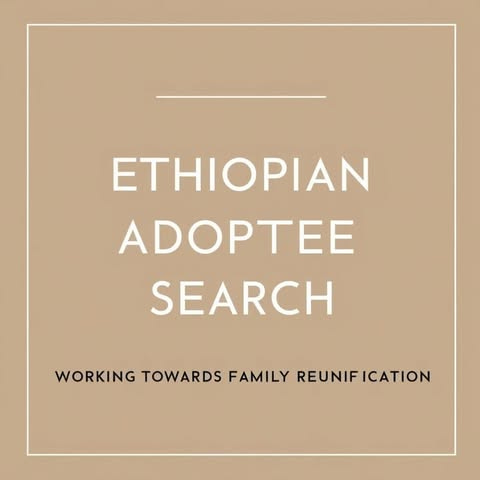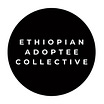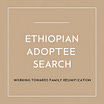Ethiopian Adoptee Search: Mid-Year Review
Some stats, an update on how it's going, and what I've learned so far.
Note on language used: I don’t use the term birth family. I use “Ethiopian family” or just “family”.
Last November, I launched Ethiopian Adoptee Search (EAS), a social media-based platform to help Ethiopian families and adoptees search and reunite.
I decided to start EAS because I’d been receiving messages from family members in Ethiopia for years, asking me to help them find their family members lost to adoption. I use the term “lost” intentionally; Ethiopian families did not know what adoption meant and did not consent to being permanently separated from their children. Families were told that their children were going abroad to get an education, and they would receive updates and photos.
In most cases, Ethiopian families did not receive updates from adoption agencies after their children were placed. Some adoptive parents re-established contact with their adopted children’s families through paid searches. These searchers were usually connected to adoption agencies and often participated in sourcing children for them.
But just because adoptive parents found their adopted children’s family doesn’t always translate to adoptees having access to their family. It’s not uncommon for adoptive parents to withhold information and/or control contact, preventing adoptees from building relationships with their family members.
From my understanding of the situation, the searching business boomed once news reports and stories started surfacing that Ethiopian adoption was rife with fraud; that Ethiopian families were tricked into giving their children away.
Still, there are adoptive parents and adoptees who have searched with or without searchers, with little or a substantial amount of information, but who have not been able to locate family members.
Where EAS comes in…
My goal with EAS is to make searching more accessible by sharing information online, free of cost. The idea is to use community contacts and the general public to help spread the word that adoptees and families are looking for each other. Sharing information is not the entire solution, but it can jump-start the search process.
I am not opposed to searchers being compensated for their work - it is labour. However, the same people who made money trafficking us, are usually the same ones benefiting from our returns - they have become the trusted searchers, translators, and drivers. Their power comes from having access to information that adoptees and adoptive families do not easily have access to: information about who our families are and where they are, and how to communicate with them. Adoptees should have access to this information, and it should not be gatekept by those who actively participated and financially benefited from trafficking children (aka Ethiopian adoption).
Every time I talk to Ethiopians about family searches, someone always suggests that adoptees go on EBS TV, but I always tell them that it’s not enough. EBS is entertainment, searching, and reuniting should be reduced to audience approval or ratings. It creates a hierarchy as well, between newsworthy stories and ones that are not. But more importantly, there are too many of us to appear on EBS. There are over 16,000 adoptees adopted to the US alone.
Ethiopian adoption was responsible for separating thousands of children from their families, without their full consent. We deserve so much more than what EBS can offer.
Some mid-year stats
I want to be transparent about what I’ve been doing with EAS and how it’s been going. Searching and reuniting is private, so I will not share specific details. The stats I’ve shared below are from helping adoptees and Ethiopian family members search for each other, as of November 2024. All requests were sent to me privately or by completing submission forms. To make the process more systemic, I now require everyone to complete a submission form.
Ethiopian family members searching for adoptees:
Requests by Ethiopian family members (accepted): 14
Requests by Ethiopian family members (rejected): 1
Countries of adoption: US, Italy, Sweden, Spain, France, Australia, Canada
Adoptees found (confirmed): 4
Adoptees found (unconfirmed): 1
I did not post every submission online for different reasons, but I was able to find 5 adoptees with the help of my contacts in various countries. Out of the 5 adoptees found, some adoptees have chosen not to reunite with their family or to maintain contact with them. I only share this information so that people know that not every adoptee wants to search or reunite with family members. I respect every adoptee’s choice.
Almost all of the adoptees that I helped to reunite with family were adopted at older ages; they were either able to identify their family members, or their family members had enough information to identify them. In other words, DNA testing was not needed.
Only submission by an Ethiopian family was rejected because the adoptee was not yet 18 years old.
Ethiopian adoptees searching for family members:
Requests by adoptees searching for family (accepted): 15
Countries of adoption: US, Italy, France, the Netherlands, Denmark
Family members found (with the help of EAS): 0
Family members found (by adoptees themselves, without the help of EAS ): 3
Ethiopian adoptees searching for family members in Ethiopia is more challenging. I haven’t been able to find anyone’s family members yet, but it’s only been 6 months. The 3 adoptees who found their families did so on their own, either by going back to Ethiopia to search, by DNA testing, or by sharing information on social media.
The majority of submissions I receive from adoptees are not “easy” cases. If I do receive some leads (possible matches), DNA testing will likely be required to determine them. I mention this to underscore that searching is a process with several steps, especially for those adopted as infants or those lacking information to identify family members.
What else to know about EAS
- I haven’t done any promotion besides sharing on social media platforms (Instagram, Facebook, TikTok).
- I’ve gotten the most engagement from Instagram and TikTok.
-I screen and vet every submission: I do follow-ups after every submission to ensure that requests meet requirements (e.g., adoptees must be 18 years old), and ask clarifying questions to make sure I understand the information in each request. Sometimes, I have trusted friends call Ethiopian family members to confirm certain information.
-Volunteers from the Ethiopian community revise every translation (Amharic, Wolaytegna, Tigrinya, Afaan Oromo, etc.)
-It is a free service for the community; no money is exchanged (and no bartering either!)
What I’ve learned so far
It is much easier to find adoptees in the diaspora than it is to find people in Ethiopia, which is not surprising! I’m happy that EAS has gotten off to a slow start, because I am unable to handle a large number of requests. Every submission matters, and I take my time so that every submission gets the attention it deserves. There’s a delay sometimes because I do have time constraints, and the volunteers who help me with translations also have busy schedules.
EAS is a service for the community, and as much as I enlist other people to help me revise the translations, it’s very much a one-person show. Besides EAS, I’ve been working on a few other important adoptee-related projects too.
While I’m taking a break for the summer months of July and August, my goal for fall 2025 is to focus more on building EAS and making connections with Ethiopian and diaspora based organizations who can help spread the word. So far, Nuro BeSheger, a YouTube channel with over 131K subscribers, is kindly re-posting for us. I’m grateful for this support and hope to make more connections in the last half of 2025 so that more adoptees and families can reunite in an accessible way.
-Kassaye Berhanu-Mac Donald








Thank you for the valuable work that you are doing!
Thank you, Dawn!